Chapter 11: Realistic Fiction
Introduction
Realistic fiction creates imaginary characters and situations that depict our world and society. It focuses on themes of growing up and confronting personal and social problems. This genre portrays characters coming to understand themselves and others.
Characteristics of Realistic Fiction:
- Realistic fiction stories tend to take place in the present or recent past.
- Characters are involved in events that could happen.
- Characters live in places that could be or are real.
- The characters seem like real people with real issues solved in a realistic way
- The events portrayed in realistic fiction conjure questions that a reader could face in everyday life (McQuade Library, 2022, n.p.)
Main Content
History of Realistic Fiction
It originated with the realist art movement that began with mid-nineteenth-century French literature (Stendhal) and Russian literature (Alexander Pushkin). Literary realism attempts to represent familiar things as they are. Realist authors chose to depict every day and banal activities and experiences. American Realism began as a reaction to and a rejection of Romanticism, with its emphasis on emotion, imagination, and the individual. The movement began as early as the 1830’s but reached prominence and held sway from the end of the Civil War to around the end of the nineteenth century.

But at the beginning of the eighteenth century, Realism was something new, and Daniel Defoe was one of the first writers to practice it. In fact, the “publication of Robinson Crusoe (1719) by Daniel Defoe marked the beginning of realistic fiction as a genre of literature” (Buss & Karnowski, 2000, p. 7), which led to other adventure books, such as The Swiss Family Robinson by Johann Wyss (1812) and Treasure Island (1883) and Kidnapped (1886) by Robert Louis Stevenson (Short, Lynch-Brown, & Tomlinson, 2018, pp. 123-124).
Types of Realistic Fiction
Within the genre of realistic fiction in children’s literature there are many types of texts that highlight “the child’s world of relationships with self and others” (Short, Lynch-Brown, & Tomlinson, 2018, p. 125) with a wide range of emotions and experiences. In addition, there are texts that include events that can lead them to be categorized by more than one type; for example, a realistic fiction text may both focus on situations surrounding the main character’s family, such as going through divorce or a death, as well as the issues that they are facing with friendships at school.
Families
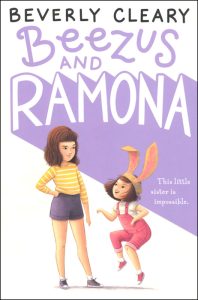
Since families are at the center of children’s lives, many realistic fiction books focus on family relationships and experiences. The stories can range from humorous to serious, and may show common activities that many people can relate to, such as cooking dinner or doing homework (Short, Lynch-Brown, & Tomlinson, 2018). One popular, long-enduring example of humorous realistic fiction that revolves around a family is the Ramona series by Beverly Cleary (starting with the first book, Beezus and Ramona, first published in 1955) and earning Newbery Honor awards for two books in the series, Ramona and Her Father (1977) and Ramona Quimby, Age 8 (1981). These books contain episodic plots in which “the author tells short stories that are related by setting or characters” (Buss & Karnowski, 2000, p. 10).
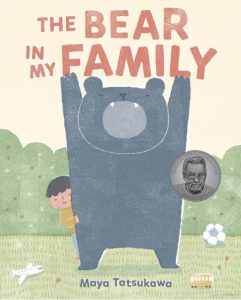
Other humorous stories may have progressive plots in which “the story begins with one event and all the other events are tied to the same story line” (p. 10). In Maya Tatsukawa’s picture book with a progressive plot, The Bear in My Family (2020), the young child in a family shares all the bad things about having a bear in their family and at the end, shares the good things, as well as the bear is their older sister. An example of a humorous chapter book with a progressive plot is The Lemonade War by Jacqueline Davies (2009), the first book in a series, in which a brother and sister, Evan and Jessie, get caught up in a war to see who can make the most money selling lemonade.
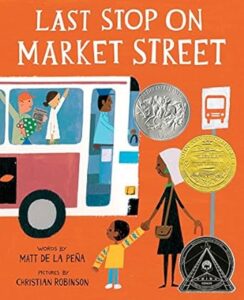
Many stories with families at the center are more serious in nature. For example, in Last Stop on Market Street by Matt de la Pena (2015), CJ and his Nana leave church and wait for the bus in the rain. When he sees his friend drive by in his family’s car, CJ wonders why they can’t have a car. As they ride the bus and get to their final destination, his Nana helps him see the beauty all around him and in the people he meets along the way. This story highlights how children may want what they don’t have, but they can learn to appreciate what they do have.
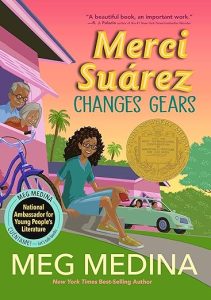 Another book with a grandparent at its center is Merci Suárez Changes Gears by Meg Medina (2018; winner of the Newbery Medal) in which Merci’s family of three generations lives in three houses in a row in their Florida neighborhood. As Merci navigates sixth-grade at a private school where she and her older brother are scholarship students, something is happening with her grandfather, Lolo, who is not acting like himself, such as forgetting names. Merci can tell that the other adults in her family are not telling her what is happening, but Lolo is the person who usually helps her with issues she’s facing, so all this worries Merci.
Another book with a grandparent at its center is Merci Suárez Changes Gears by Meg Medina (2018; winner of the Newbery Medal) in which Merci’s family of three generations lives in three houses in a row in their Florida neighborhood. As Merci navigates sixth-grade at a private school where she and her older brother are scholarship students, something is happening with her grandfather, Lolo, who is not acting like himself, such as forgetting names. Merci can tell that the other adults in her family are not telling her what is happening, but Lolo is the person who usually helps her with issues she’s facing, so all this worries Merci.
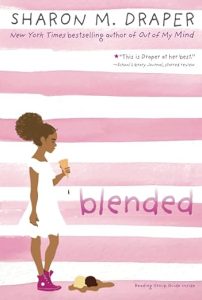 Since many children experience their parents divorcing, there are many realistic fiction books with divorce at the center of the problems the main character has. In I Have Two Homes written by Marian De Smet and illustrated by Nynke Talsma (2012), Nina describes her life when her parents get divorced and she has two houses. Another example is Blended by Sharon Draper (2018) in which eleven-year-old Isabella, who is bi-racial with a white mother and black father, has parents who are divorced, so she alternates weeks with her dad, his girlfriend and her son and with her mom and boyfriend. As she navigates living in two houses with completely different experiences, Isabella also is trying to figure out who she is.
Since many children experience their parents divorcing, there are many realistic fiction books with divorce at the center of the problems the main character has. In I Have Two Homes written by Marian De Smet and illustrated by Nynke Talsma (2012), Nina describes her life when her parents get divorced and she has two houses. Another example is Blended by Sharon Draper (2018) in which eleven-year-old Isabella, who is bi-racial with a white mother and black father, has parents who are divorced, so she alternates weeks with her dad, his girlfriend and her son and with her mom and boyfriend. As she navigates living in two houses with completely different experiences, Isabella also is trying to figure out who she is.
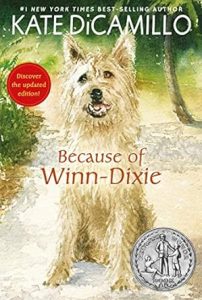 There are numerous realistic fiction books in which the family has suffered the loss of a loved one. One type of loss is when a parent leaves the family, which is what Opal, the main character in Because of Winn-Dixie by Kate DiCamillo (2000), experiences when her mother left when she was a young girl. In the book, Opal just moved to a new town with her father, the Preacher. After she finds a dog in the Winn-Dixie supermarket, who she names Winn-Dixie, her father begins to tell Opal ten things about her mother. Winn-Dixie has a special gift of making friends and helps Opal make them in her new town.
There are numerous realistic fiction books in which the family has suffered the loss of a loved one. One type of loss is when a parent leaves the family, which is what Opal, the main character in Because of Winn-Dixie by Kate DiCamillo (2000), experiences when her mother left when she was a young girl. In the book, Opal just moved to a new town with her father, the Preacher. After she finds a dog in the Winn-Dixie supermarket, who she names Winn-Dixie, her father begins to tell Opal ten things about her mother. Winn-Dixie has a special gift of making friends and helps Opal make them in her new town.
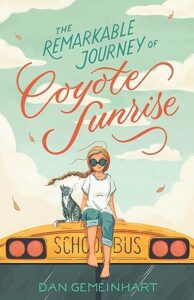 Another loss can be the death of a loved one. In The Remarkable Journey of Coyote Sunrise by Dan Gemeinhart (2019), Coyote lives in a school bus with her father, Rodeo, driving around the country. Coyote and Rodeo have suffered a tremendous loss when their family was in a car accident and Coyote’s mother and two sisters died. Coyote finds out that something is happening in her hometown and needs to travel across the country to get there without telling Rodeo where they are going. Their journey helps to heal their grief and figure out how to move forward.
Another loss can be the death of a loved one. In The Remarkable Journey of Coyote Sunrise by Dan Gemeinhart (2019), Coyote lives in a school bus with her father, Rodeo, driving around the country. Coyote and Rodeo have suffered a tremendous loss when their family was in a car accident and Coyote’s mother and two sisters died. Coyote finds out that something is happening in her hometown and needs to travel across the country to get there without telling Rodeo where they are going. Their journey helps to heal their grief and figure out how to move forward.
Friends and Bullies
 Children have to navigate many relationships outside their families, particularly with having friendship issues and more serious situations in which they experience bullying (Short, Lynch-Brown, & Tomlinson, 2018). The picture book, Evelyn Del Rey Is Moving Away by Meg Medina and illustrated by Sonia Sánchez (2020) tells the story of two best friends, Daniela and Evelyn, on the day that Evelyn is moving away from their apartments that are almost twins to a new house that won’t be a match to Daniela’s. The book shares what the best friends do until it’s time for Evelyn to leave and all the sad feelings that both friends experience.
Children have to navigate many relationships outside their families, particularly with having friendship issues and more serious situations in which they experience bullying (Short, Lynch-Brown, & Tomlinson, 2018). The picture book, Evelyn Del Rey Is Moving Away by Meg Medina and illustrated by Sonia Sánchez (2020) tells the story of two best friends, Daniela and Evelyn, on the day that Evelyn is moving away from their apartments that are almost twins to a new house that won’t be a match to Daniela’s. The book shares what the best friends do until it’s time for Evelyn to leave and all the sad feelings that both friends experience.
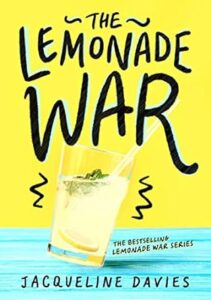 In The Lemonade War described above (Davies, 2009), Jessie has always considered Evan her best friend because she struggles with making friends in her own class. Because she is very smart, particularly in math, she is going to skip a grade and be in Evan’s class, so she tries to become friends with a girl in her new class. Evan makes friends easily but has his own friendship issue with a boy in his class who takes advantage of him.
In The Lemonade War described above (Davies, 2009), Jessie has always considered Evan her best friend because she struggles with making friends in her own class. Because she is very smart, particularly in math, she is going to skip a grade and be in Evan’s class, so she tries to become friends with a girl in her new class. Evan makes friends easily but has his own friendship issue with a boy in his class who takes advantage of him.
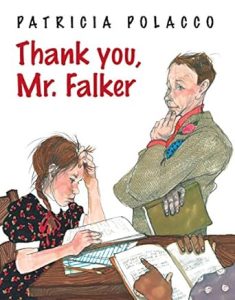 There are several books by beloved author Patricia Polacco that have main characters who face bullying. In Thank You, Mr. Falker (1998), the main character, Trisha, struggles learning to read and experiences bullying. She is able to overcome her disability through her own strength and by the support of her teacher, Mr. Falker. The story is more powerful because it is based on Patricia Polacco’s own experience with dyslexia. While in Thank You, Mr. Falker, Patricia Polacco writes about the bullying that Trisha experiences, in Mr. Lincoln’s Way (2001), she writes about the bully. Mr. Lincoln is the principal and is concerned about Eugene, known as “Mean Gene,” because he is the school bully. One day, he learns that Eugene loves birds, so as he fosters this interest in Eugene, he gets to know him, trying to understand what makes him want to bully other students in the school.
There are several books by beloved author Patricia Polacco that have main characters who face bullying. In Thank You, Mr. Falker (1998), the main character, Trisha, struggles learning to read and experiences bullying. She is able to overcome her disability through her own strength and by the support of her teacher, Mr. Falker. The story is more powerful because it is based on Patricia Polacco’s own experience with dyslexia. While in Thank You, Mr. Falker, Patricia Polacco writes about the bullying that Trisha experiences, in Mr. Lincoln’s Way (2001), she writes about the bully. Mr. Lincoln is the principal and is concerned about Eugene, known as “Mean Gene,” because he is the school bully. One day, he learns that Eugene loves birds, so as he fosters this interest in Eugene, he gets to know him, trying to understand what makes him want to bully other students in the school.
Animals
“Our lives are full of animals – in our homes, outdoor spaces, and sometimes even our classrooms. It makes sense that they would find their way into children’s literature, which seeks to put the world into children’s hands” (Runge, 2022, n.p.). For centuries, children have enjoyed stories with animals in them. The animals and people in realistic fiction stories could exist in the world as we know it. The story could really happen. That means no talking pets that wear clothes, and no fairytale creatures. Reading about realistic characters with different experiences can help us empathize better with the people and animals in our real lives.
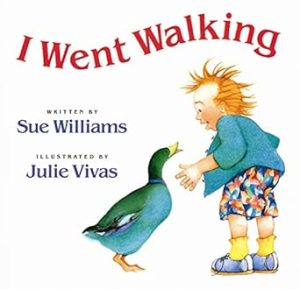 Authors will often use animals in realistic picture books to start teaching children the basic facts about animals. They are used to teach children everything from what the animal looks like, how to spell their name, the sounds they make, to the behaviors they exhibit. One example of this is the picture book I Went Walking, written by Sue Williams and illustrated by Julie Vivas (1989). In this story a child goes on a walk and comes across several different animals. These animals look like they are supposed to and do not talk or wear clothes. Children reading this story get a better understanding of what real animals look and act like. Adults can use this book to have their children understand different animals, get their child to make the animal sounds, and even talk about their habitats. This is a great way to start introducing animals that will segue into more thought provoking ideas as they get older.
Authors will often use animals in realistic picture books to start teaching children the basic facts about animals. They are used to teach children everything from what the animal looks like, how to spell their name, the sounds they make, to the behaviors they exhibit. One example of this is the picture book I Went Walking, written by Sue Williams and illustrated by Julie Vivas (1989). In this story a child goes on a walk and comes across several different animals. These animals look like they are supposed to and do not talk or wear clothes. Children reading this story get a better understanding of what real animals look and act like. Adults can use this book to have their children understand different animals, get their child to make the animal sounds, and even talk about their habitats. This is a great way to start introducing animals that will segue into more thought provoking ideas as they get older.
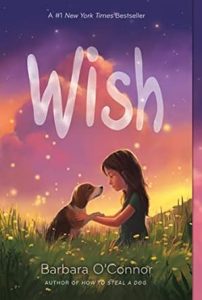 Animals can “play a crucial role in writing and reveal hidden messages to readers found within the writing” and “how animals themselves bring meanings to books that human characters alone cannot do” (Grades Fixer, 2021, n.p.). Wish by Barbara O’Connor (2016) is a book with an animal at the center that tells the story of a young girl, Charlie. Her father is in jail and her mother can’t get out of bed, so Charlie is sent to live with her aunt and uncle in the Blue Ridge Mountains of North Carolina. There’s a stray dog who lives in the area near her house, who Charlie is determined to have as her own dog and she names him Wishbone. As Charlie takes care of Wishbone, she begins to feel secure and loved and discovers the true meaning of having a family and friends.
Animals can “play a crucial role in writing and reveal hidden messages to readers found within the writing” and “how animals themselves bring meanings to books that human characters alone cannot do” (Grades Fixer, 2021, n.p.). Wish by Barbara O’Connor (2016) is a book with an animal at the center that tells the story of a young girl, Charlie. Her father is in jail and her mother can’t get out of bed, so Charlie is sent to live with her aunt and uncle in the Blue Ridge Mountains of North Carolina. There’s a stray dog who lives in the area near her house, who Charlie is determined to have as her own dog and she names him Wishbone. As Charlie takes care of Wishbone, she begins to feel secure and loved and discovers the true meaning of having a family and friends.
 Anna Sewell uses her story Black Beauty (1877) to show the treatment and needs of horses by having the narrative being told from the horse’s perspective. Her use of the first “person” point of view not only helps “to educate readers about equine needs,” but “to highlight the powerful companionship horses can bring to a person” (Grades Fixer, 2021, n.p.). Using this technique allows the reader to get into the mindset of the horse and teaches the reader how to handle situations of companionship versus ownership and poverty versus wealth. It helps to teach compassion and understanding. Sometimes these topics are difficult to talk about or just teach. Children often learn through example, so reading stories about animals gives them more insight into the animal’s worlds and (hopefully) a way to live with them and treat them well.
Anna Sewell uses her story Black Beauty (1877) to show the treatment and needs of horses by having the narrative being told from the horse’s perspective. Her use of the first “person” point of view not only helps “to educate readers about equine needs,” but “to highlight the powerful companionship horses can bring to a person” (Grades Fixer, 2021, n.p.). Using this technique allows the reader to get into the mindset of the horse and teaches the reader how to handle situations of companionship versus ownership and poverty versus wealth. It helps to teach compassion and understanding. Sometimes these topics are difficult to talk about or just teach. Children often learn through example, so reading stories about animals gives them more insight into the animal’s worlds and (hopefully) a way to live with them and treat them well.
We continue to see animals used in realistic fiction because they are part of our lives. Whether we live in the country or the city, animals are all around us. This is why authors have used and will continue to use animals in realistic stories.
Mysteries
Mystery is a type of literary genre “whose stories focus on a puzzling crime, situation, or circumstance that needs to be solved” (Literary Terms, 2015). Almost all mystery stories share the same types of characteristics or elements. These elements lead the reader to be involved in the story. To involve the reader, the author must create well-structured or thought out chapters so the story follows a natural sequence. The use of language to create suspense and set the mood will hook the reader. There needs to be strong language such as suspenseful dialogue and mood. If the author doesn’t involve the reader at the beginning with this type of language, the stories may fall flat and the reader doesn’t get invested in figuring out the answer or solution.
Reading mysteries when you are a child will also help develop stronger deduction or logical thinking skills which will help in all other subject areas. It allows children to ask “WHY” and try to find the clues the author has hidden to help them figure out the solution (Scholastic: Parents, 2021). “Experiencing the mystery genre, also provides opportunities for students to think critically—to ask questions, make inferences, draw conclusions, analyze characters, reason deductively and to make connections” (Bickel, 2015, n.p.).
Are there any Red Herrings in the story to confuse the reader? Red Herrings are parts of the story used to divert the reader’s attention away from something else happening in the story. William Cobbett first introduced the term Red Herring in a short story written in 1807. He used the smoky, smelly fish, the true term for what a red herring is, as a disguise to cover up an event in the story. It distracted the reader enough to lead them to a different answer (Wikipedia, 2022). Other famous mystery writers like Agatha Christie and Sir Arthur Conan Doyle used red herrings a great deal in their writings to make their solutions a bit more difficult to solve and that’s the part we all love about mysteries, seeing if we can solve it before the last page.
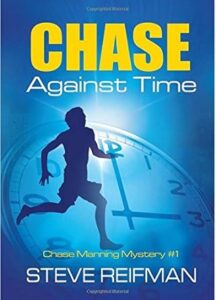 Children’s mystery writers started using this literary device in their writings. Author Steve Reifman of Chase Against Time (2012), explains this in detail in his video on YouTube that is in the Resources section of this chapter. Readers can also find the use of Red Herrings in the Book Scavenger series by Jennifer Chambliss Bertman (2019), mystery books by Blue Balliett, such as the first book in the Chasing Vermeer (2004) series, The Westing Game by Ellen Raskin (1978), and many more.
Children’s mystery writers started using this literary device in their writings. Author Steve Reifman of Chase Against Time (2012), explains this in detail in his video on YouTube that is in the Resources section of this chapter. Readers can also find the use of Red Herrings in the Book Scavenger series by Jennifer Chambliss Bertman (2019), mystery books by Blue Balliett, such as the first book in the Chasing Vermeer (2004) series, The Westing Game by Ellen Raskin (1978), and many more.
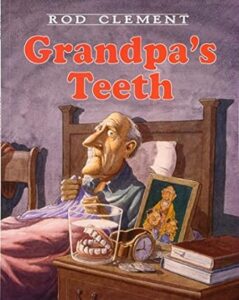 Children who start reading mysteries early in life will be introduced to the reading skills described above. The logical and critical thinking skills start to develop. Grandpa’s Teeth by Rod Clement (1998) is one such book. This funny book tries to figure out what happened to Grandpa’s teeth and the crazy town they live in (Hurst, 2021).
Children who start reading mysteries early in life will be introduced to the reading skills described above. The logical and critical thinking skills start to develop. Grandpa’s Teeth by Rod Clement (1998) is one such book. This funny book tries to figure out what happened to Grandpa’s teeth and the crazy town they live in (Hurst, 2021).
There are many children’s books from picture to chapter book to encourage children to use their brains, think critically, and use deduction skills to solve a mystery or find a solution to a problem. These are not skills easily taught so using stories to help children develop these skills are essential as they will use them in all aspects of their lives.
Sports
“No matter what the reason, Realistic Fiction- specifically sports- are popular books no matter what age. Sports are a common theme in our culture today and reading about them is what can make them special” (Realistic Fiction Sports Book, n.d., n.p.). Sports books also provide “a definite “hook” for many reluctant readers” (Redeemed Reader, 2022, n.p.). Sports books are great for many reasons. They offer not just a good story but can help readers with learning about teamwork, perseverance, issues that many people deal with on a daily basis, and can help with relationship issues.
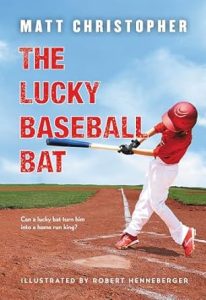 Matt Christopher was one of the first authors to focus on sport stories for young readers. He had a hard time getting a publisher to accept his stories at first. It wasn’t until 1954 that Little, Brown Publishers picked up The Lucky Baseball Bat and now he has been considered a major author in this genre for decades (Matt Christopher, 2022). The Lucky Baseball Bat is a story about a boy, Marty, who loses his “lucky” baseball bat. As the story progresses, Marty starts having trouble playing and he blames it all on not having his bat. His confidence starts to go away as he keeps striking out and not getting any hits. He learns from his coaches and teammates that it’s not his bat that is a good hitter, it is him. Once Marty realizes they are all correct, he starts playing better. Then in the end when he finds his bat, he understands that it is his hard work that makes him a good player, not the piece of wood he uses to play the game.
Matt Christopher was one of the first authors to focus on sport stories for young readers. He had a hard time getting a publisher to accept his stories at first. It wasn’t until 1954 that Little, Brown Publishers picked up The Lucky Baseball Bat and now he has been considered a major author in this genre for decades (Matt Christopher, 2022). The Lucky Baseball Bat is a story about a boy, Marty, who loses his “lucky” baseball bat. As the story progresses, Marty starts having trouble playing and he blames it all on not having his bat. His confidence starts to go away as he keeps striking out and not getting any hits. He learns from his coaches and teammates that it’s not his bat that is a good hitter, it is him. Once Marty realizes they are all correct, he starts playing better. Then in the end when he finds his bat, he understands that it is his hard work that makes him a good player, not the piece of wood he uses to play the game.
 Mike Lupica, another popular author in the sports sub-genre, “is a longtime sports columnist and commentator” (Corneal, 2022, n.p.). “The world of sports, he says, ‘teaches kids about being on a team, being part of something greater than themselves if they play hard and well and unselfishly. If they can learn that, they can apply it to anything they do, in or out of sports, for the rest of their lives’” (as cited in Corneal, 2022, n.p.). His first young adult novel was Travel Team (2004) about a boy, Danny, who is cut from the basketball team and how he and his dad handle the situation.
Mike Lupica, another popular author in the sports sub-genre, “is a longtime sports columnist and commentator” (Corneal, 2022, n.p.). “The world of sports, he says, ‘teaches kids about being on a team, being part of something greater than themselves if they play hard and well and unselfishly. If they can learn that, they can apply it to anything they do, in or out of sports, for the rest of their lives’” (as cited in Corneal, 2022, n.p.). His first young adult novel was Travel Team (2004) about a boy, Danny, who is cut from the basketball team and how he and his dad handle the situation.
There are many athletes that write sports stories today. They want to share their wisdom and stories to help other athletes, especially young ones. Young readers learn a great deal in reading stories about something they love and if it help teach them life lessons along the way, well, that’s even better.
Here are some other sport-themed books to consider reading:
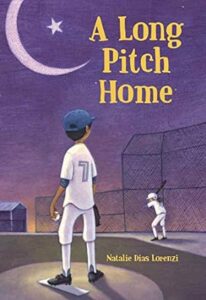 A Long Pitch Home by Natalie Dias Lorenzi (2016):
A Long Pitch Home by Natalie Dias Lorenzi (2016):
Bilal is a 10 year old boy from Pakistan. He is a great cricket player, but one day his father moves the family to the United States. Now Bilal has to learn a new language and sport. He joins his cousin’s baseball team but all he really wants is his father to join the family in Virginia. Bilal works on his relationships with his teammates to learn a new sport and live in a new country in hopes that they can work together to have his father see him play.
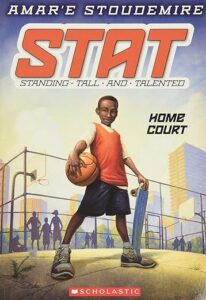 Home Court (STAT: Standing Tall and Talented series) by Amar’e Stoudemire (2012):
Home Court (STAT: Standing Tall and Talented series) by Amar’e Stoudemire (2012):
Amar’e Stoudemire is 11 and very talented and athletic. He loves skateboarding, working hard in school, helping his dad out in his business, and playing basketball for fun. One day some older boys are giving his friends a hard time on their neighborhood court. Amar’e steps in and uses his
natural ability and intelligence to help his friends win against the older boys. He rises to the challenge to help them succeed.
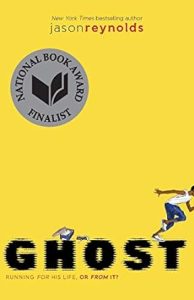 Ghost by Jason Reynolds (2016):
Ghost by Jason Reynolds (2016):
This is the first in a fab series of books starring four kids from very different backgrounds, all chosen to run track for an elite middle school team that could lead them to the Junior Olympics. Castle Crenshaw, aka Ghost, has natural running ability, but he has faced many challenges in his life, such as experiencing trauma at the hands of his father as a young boy, as well as not having the right running shoes for the team. Can Ghost overcome these challenges to meet his true potential?
Facing Challenges
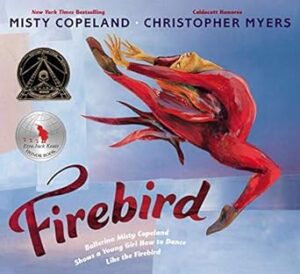 Just like Ghost described above, many realistic fiction books have children who “must deal with difficult challenges in their lives” (Short, Lynch-Brown, & Tomlinson, 2018, p. 126). In the beautiful picture book Firebird by Misty Copeland (2014), the famous ballerina encourages a young dancer who doesn’t have the confidence that she can make it as a ballerina and Misty assures her that she was once in her place and worked hard and persevered, reaching new heights.
Just like Ghost described above, many realistic fiction books have children who “must deal with difficult challenges in their lives” (Short, Lynch-Brown, & Tomlinson, 2018, p. 126). In the beautiful picture book Firebird by Misty Copeland (2014), the famous ballerina encourages a young dancer who doesn’t have the confidence that she can make it as a ballerina and Misty assures her that she was once in her place and worked hard and persevered, reaching new heights.
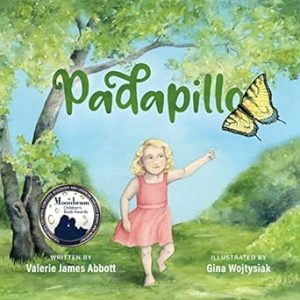 Another challenge may be the main character having a disability or someone close to them with one and “well-written, honest stories can help children gain an understanding of, and empathy with, people who have disabilities” (Short, Lynch-Brown, & Tomlinson, 2018, p. 126). In Padapillo, written by Valerie James Abbott and illustrated by Gina Wojtysiak (2021), older sister, Mary Clare, notices that her little sister, Bridget, does weird things, such as not noticing when the doorbell or phone ring. Their parents take her to an audiologist who determines that she has hearing loss and needs hearing aids. The book is written so that families can learn what the process is when they believe their child has hearing loss and that there can be hope for support and improvement.
Another challenge may be the main character having a disability or someone close to them with one and “well-written, honest stories can help children gain an understanding of, and empathy with, people who have disabilities” (Short, Lynch-Brown, & Tomlinson, 2018, p. 126). In Padapillo, written by Valerie James Abbott and illustrated by Gina Wojtysiak (2021), older sister, Mary Clare, notices that her little sister, Bridget, does weird things, such as not noticing when the doorbell or phone ring. Their parents take her to an audiologist who determines that she has hearing loss and needs hearing aids. The book is written so that families can learn what the process is when they believe their child has hearing loss and that there can be hope for support and improvement.
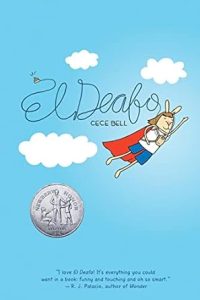 Another book with a character with hearing loss, written as a graphic novel, is Cece Bell’s somewhat autobiographical book, El Deafo (2014), that tells the story of a girl who needs to wear a hearing aid and adopts the persona of El Deafo in which her hearing aid is her superpower. The story shares how Cece navigates friendships and how she handles people who treat her differently due to her disability. August, the main character in Wonder by R. J. Palacio (2012), was born with a disfigured face. After being homeschooled, his parents decide he should go to school in fifth grade and he experiences bullying because of how he looks. He learns who his true friends are and overcomes his challenges to shine.
Another book with a character with hearing loss, written as a graphic novel, is Cece Bell’s somewhat autobiographical book, El Deafo (2014), that tells the story of a girl who needs to wear a hearing aid and adopts the persona of El Deafo in which her hearing aid is her superpower. The story shares how Cece navigates friendships and how she handles people who treat her differently due to her disability. August, the main character in Wonder by R. J. Palacio (2012), was born with a disfigured face. After being homeschooled, his parents decide he should go to school in fifth grade and he experiences bullying because of how he looks. He learns who his true friends are and overcomes his challenges to shine.
 With the number of multilingual students in U.S. classrooms, some realistic fiction books address challenges they face. I Hate English! by Ellen Levine (illustrated by Steve Björkman; 1989) is a book about Mei Mei who moved from her beloved Hong Kong to New York City with her family. She didn’t want to move and resists speaking English until she meets someone who helps her understand why she can speak both Chinese and English. Between Us and Abuela: A Family Story from the Border, written by Mitali Perkins and illustrated by Sara Palacios (2019), tells the story of a family separated by immigration. Maria, her mother and brother travel to the border of California and Mexico so that they can see their grandmother for a Christmas visit along the border fence.
With the number of multilingual students in U.S. classrooms, some realistic fiction books address challenges they face. I Hate English! by Ellen Levine (illustrated by Steve Björkman; 1989) is a book about Mei Mei who moved from her beloved Hong Kong to New York City with her family. She didn’t want to move and resists speaking English until she meets someone who helps her understand why she can speak both Chinese and English. Between Us and Abuela: A Family Story from the Border, written by Mitali Perkins and illustrated by Sara Palacios (2019), tells the story of a family separated by immigration. Maria, her mother and brother travel to the border of California and Mexico so that they can see their grandmother for a Christmas visit along the border fence.
Bibliotherapy
Children’s literature can support children’s social-emotional development and one way is through bibliotherapy. A broad definition of bibliotherapy “is any kind of emotional healing that comes from reading books” (Tunnell, Jacobs, Young, and Bryan, 2012, p. 4). Chatton (1988, as cited in Tunnell, Jacobs, Young, & Bryan, 2012) describes “the particular information and insight books can provide in dealing with specific personal problems” (p. 4). While trained psychologists and psychotherapists should be the professionals who specifically use bibliotherapy in their practices to support children and adolescents’ personal problems, teachers, parents and librarians can support children’s social-emotional development by “reading and recommending good books and allowing personal insight, comfort, and the answering of troubling questions to come in their own natural and timely ways” (Tunnell, Jacobs, Young, & Bryan, 2012, p. 4).
As many of the books highlighted in the sections above share, children face challenges in their everyday lives; some of these challenges are minor, such as the friendship issues that Evan and Jessie experience in The Lemonade War (Davies, 2009), while some are more serious. From identity issues, such as Isabella fitting into two families in Blended (Draper, 2018), to disabilities, similar to Cece being deaf in El Deafo (Bell, 2014), or the bullying that Trisha faces in Thank You, Mr. Falker (Polacco, 1998), or the loss or death of loved ones, which Coyote experienced in The Remarkable Journey of Coyote Sunrise (Gemeinhart, 2019), books can help children navigate their feelings and how to handle these problems. There are many books, those suggested here and many others, that adults who are important in children’s lives, such as parents, teachers, and others, can share with children to support their social-emotional needs.
***If you have a book recommendation for this or any chapter in this OER, please complete the Google Form: click this link.
Evaluation Questions
- “Does the story permit some cause for hope? Children need hope that is realistic to their life situation, not wishful thinking or an unlikely happy ending” (Short et al., 2018, p. 123).
- “Is the story a thin disguise for a heavy-handed moral lesson? Realistic fiction often conveys values, such as kindness and generosity, but children resist stories that preach. The moral should not overwhelm the story, but be a logical outcome” (Short et al., 2018, p. 123).
- “Is the story believable? Are the events possible, even though all aspects are not probable? Sometimes an author goes close to the edge of the believable range to produce a more exciting, suspense-filled story but still should avoid the overuse of coincidence to resolve the plot” (Short et al, 2018, p. 123).
Books
- Abbott, V.J. (2021). Padapillo. KWE Publishing, LLC.
- Balliett, B. (2004). Chasing Vermeer. Scholastic Press.
- Bell, C. (2014). El Deafo. Amulet Books.
- Bertman, J.C. (2019). Book Scavenger Series. Generic.
- Christopher, M. (1954). The Lucky Baseball Bat. Little, Brown Publishers.
- Cleary, B. (1955). Beezus and Ramona. William Morrow.
- Cleary, B. (1977). Ramona and Her Father. William Morrow.
- Cleary, B. (1981). Ramona Quimby, Age 8. William Morrow.
- Clement, R. (1998). Grandpa’s Teeth. HarperCollins.
- Copeland, M. (2014). Firebird. G.P. Putnam’s Sons.
- Davies, J. (2009). The Lemonade War. Clarion Books.
- De la Pena, M. (2015). Last Stop on Market Street. G. P. Putnam’s Sons.
- De Smet, Marian (2012). I Have Two Homes. Clavis.
- DiCamillo, K. (2000). Because of Winn-Dixie. Candlewick Press.
- Draper, S. (2018). Blended. Simon and Schuster.
- Gemeinhart, D. (2019). The Remarkable Journey of Coyote Sunrise. Henry Holt and Company.
- Levine, E. (1989). I Hate English! Scholastic Inc.
- Lorenzi, N.D. (2016). A Long Pitch Home. Charlesbridge.
- Lupica, M. (2004). Travel Team. Puffin Books.
- Medina, M. (2020). Evelyn Del Rey Is Moving Away. Candlewick Press.
- Medina, M. (2018). Merci Suárez Changes Gears. Candlewick Press.
- O’Connor, B. (2016). Wish. Thorndike Press.
- Palacio, R. J. (2012). Wonder. Alfred A. Knopf.
- Perkins, M. (2019). Between Us and Abuela: A Family Story from the Border. Farrar, Straus and Giroux.
- Polacco, P. (2001). Mr. Lincoln’s Way. Philomel Books.
- Polacco, P. (1998). Thank You, Mr. Falker. Philomel Books.
- Raskin, E. (1978). The Westing Game. Dutton.
- Reifman, S. (2012). Chase Against Time. Brown Books Publishing Group.
- Reynolds, J. (2016). Ghost. Atheneum Books.
- Sewell, A. (1877). Black Beauty. Jarrold & Sons.
- Stoudemire, A. (2012). Home Court (STAT: Standing Tall and Talented series). Scholastic, Inc.
- Tatsukawa, M. (2020). The Bear in My Family. Dial Books for Young Readers.
- Williams, S. (1989). I Went Walking. Clarion Books.
Additional Resources
Book Trailer: The Bear in My Family by Maya Tatsukawa
Book Talk: Firebird by Misty Copeland
Book Talk: Who Wet My Pants by Bob Shea
References
- Bickel, T. (2015). Mysteries in the classroom: How to hook readers with a “Whodunit” tale. https://www.booksourcebanter.com/2017/04/25/power-mysteries-classroom-captivate-readers-ages/#:~:text=Mysteries%20make%20great%20read%20alouds.%20Whether%20a%20chapter,including%20story%20elements%2C%20character%20traits%2C%20craft%20and%20structure
- Buss, K., & Karnowski, L. (2000). Teaching realistic fiction. In Reading and Writing Literary Genres (pp. 7-30). International Reading Association, Inc.
- Corneal, D.A. (2022). An introduction to Mike Lupica: Sports stories and life lessons for kids and tweens. https://www.readbrightly.com/introduction-mike-lupica/
- Grades Fixer. (2021, December 28). Animal symbolism in literature: Possibility write about sensitive themes. https://gradesfixer.com/free-essay-examples/the-significance-of-animals-in-literature/Hurst, C. (2021). Mysteries in the classroom: Fiction, nonfiction and activities for preschool through ninth grade. https://www.carolhurst.com/subjects/mysteries.html
- Literary Terms. (2015, June 1). Mystery. https://literaryterms.net/mystery/
- Matt Christopher. (2022). About the author. https://www.mattchristopher.com/about/
- McQuade Library. (2022, January 13). Realistic fiction. https://libguides.merrimack.edu/RealisticFiction
- Realistic Fiction Sports Book. (n.d.). Why should I read realistic fiction though? https://sportsbookproject.weebly.com/why-realistic-fiction.html
- Redeemed Reader. (2022). Sports books for kids that pack a punch. https://redeemedreader.com/2022/01/sports-books-that-pack-a-punch/
- Runge, R. (2022, September 23). Why are there so many animals in children’s literature? (And what you can do with them). https://www.kidpressroom.com/animals-in-childrens-literature/
- Scholastic: Parents. (2021). Improve reading with mystery books. https://www.scholastic.com/parents/family-life/parent-child/improve-reading-skills-mystery-books.html
- Short, K. G., Lynch-Brown, C. & Tomlinson, C. M. (2018). Realistic fiction. In Essentials of Children’s Literature (9th ed., pp. 121-134). Pearson Education, Inc.
- Tunnell, M.O., Jacobs, J.S., Young, T.A., & Bryan, G.W. (2012). Why read? In Children’s Literature, Briefly (5th ed., pp. 1-8). Pearson Education, Inc.
- Wikipedia. (2022, October 18). Red herring. https://en.wikipedia.org/wiki/Red_herring

